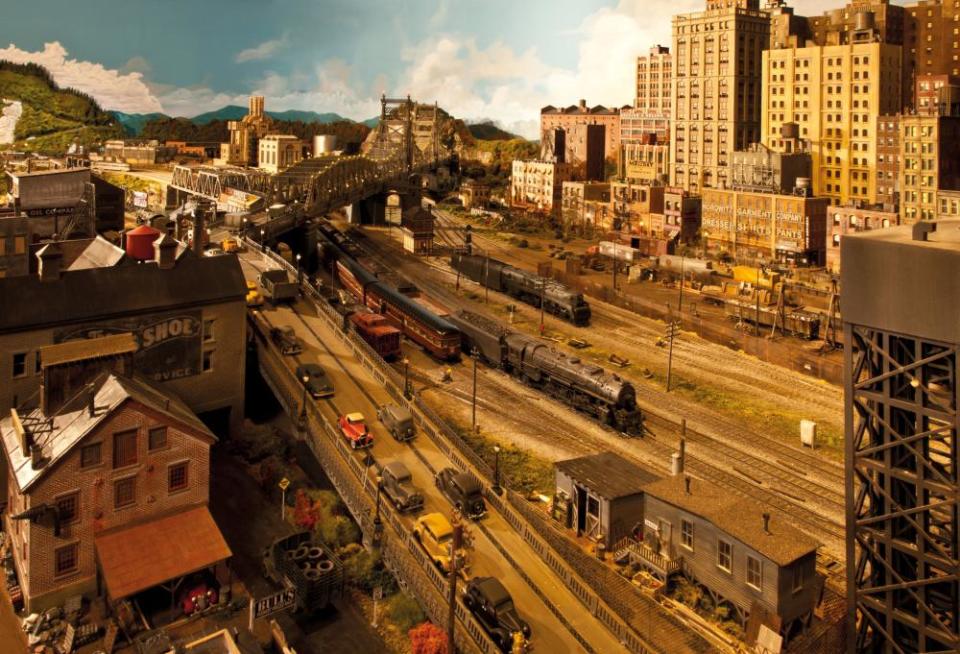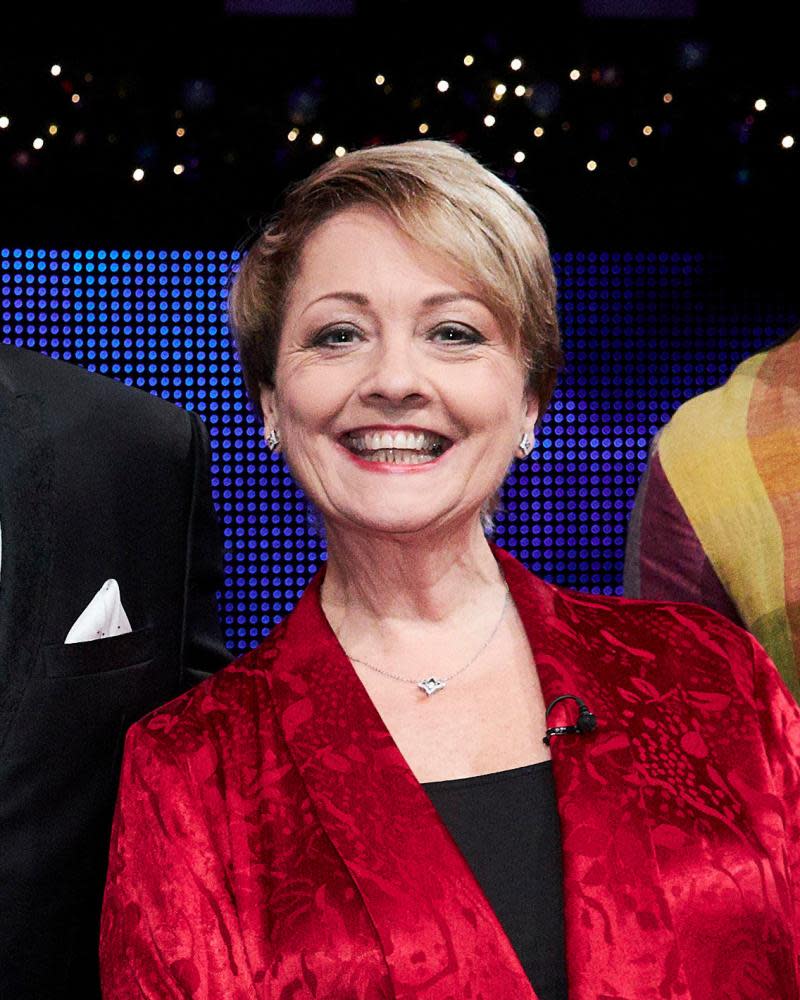‘I’m proud to be called a nerd!’ The pop and rock greats who love model railways

Rod Stewart’s setup is bigger than most houses. Pete Waterman spends his evenings making miniature trees. Neil Young filled a barn with tunnels. And they’re just the tip of the iceberg
Rod Stewart’s train setup isn’t exactly the sort of thing you would find in a child’s bedroom. His epic Grand Street & Three Rivers City is a stunningly realistic 139 sq metre (1,500 sq ft) depiction of a mid-20th-century industrialised city. Based on 1940s Manhattan and Chicago, the labour of love – which has pride of place in his Beverly Hills mansion – includes skyscrapers up to 5ft tall, warehouses, bridges and rush-hour traffic, with period cars and lorries, reproduced sections of river and even a startlingly detailed miniature power station.
“It took me 23 years to build [and it’s] bigger than most people’s houses,” he told the Guardian in November. “It’s very expensive, but worth it, ’cos it’s my favourite hobby. I work on it every day.”
Rod the Mod isn’t the only music star with a double life in railway modelling. Neil Young has a modelling alias (Clyde Coil) and reportedly at one point had a huge barn containing 230 metres of track, complete with trains, buildings, trees and tunnels. Elton John is believed to have a track running through his garden. Jools Holland’s collection, which runs to 30 metres long, includes a route from London to Berlin.

Going back a bit, Frank Sinatra was said to own $1m worth of model trains and replicas of his native Hoboken, New Jersey, which he kept in a room called – but of course – All Aboard. Rock gods known to have private passions for tiny engines and carriages include Roger Daltrey, Bruce Springsteen, Eric Clapton, Phil Collins and Ringo Starr. But perhaps the music and railway modelling worlds aren’t as different as they might seem.
Musicians have been writing songs about train travel since at least 1828, when Arthur Clifton wrote the Carrollton March to commemorate the Baltimore and Ohio Railroad, which opened two years later. The train features in many a spiritual or blues song and is often depicted as a gateway to a promised land. Woody Guthrie’s catalogue is packed with rail songs – Train Blues, This Train Is Bound for Glory and Lost Train Blues – while pop songs referencing train travel stretch from the early Elvis Presley single Mystery Train to Kraftwerk’s Trans-Europe Express and Stewart’s hit cover of Tom Waits’ Downtown Train. Some songs even have rhythms reminiscent of chugging trains, from Louis Jordan’s Choo Choo Ch’Boogie (“Take me right back to the track, Jack”) to Led Zeppelin’s version of When the Levee Breaks.
So, the fascination with trains is partly conventional nostalgia, but may be more deeply ingrained in the sounds we heard as children and the experience of riding on a train.
“I’m sure a psychologist would have a field day with us,” says Pete Waterman, the producer/songwriter behind Kylie Minogue, Rick Astley and Jason Donovan. He is one of the UK’s foremost railway modellers. “But it’s about hands-on creativity and a huge amount of research, which isn’t that different to making music.
“Rod’s work is fantastic. What he does with those American buildings takes skill. Not everybody can pick up a piece of plastic and cardboard and build like he does. Rod’s big thing is skyscrapers. Mine is trees. I’ll make them out of wire and spend hours putting all the leaves on.” This has become an obsession, to which he devotes the same energy as he once did to hit records.
“In the music industry, you’re constantly sussing out what your competitors are doing and what’s going on,” says Waterman, who recently designed and built a 20-metre-long layout in Chester Cathedral. “It’s exactly the same thought process I brought to Kylie or whoever: ‘I’ve got a No 1 single. How do I get another one?’ It’s just that, instead of wondering where I should put a cymbal, I’m thinking: ‘Does that tree work there? Is that house too close to the railway line?’ It ticks exactly the same boxes.”
He admits that sitting awake at night pondering such questions does sometimes make him think: “It’s a model railway! Am I going nuts?” There is a stigma attached, he says, especially for someone involved in music. While dreaded catcalls such as “trainspotter” and “grownup playing with toys” aren’t as potent as they were, he doesn’t think “Rod would have talked about this stuff 20 years ago”.
Waterman was a trainspotter (at Leamington Spa station, of which he has built a model) in his youth. His charity, Waterman Railway Heritage Trust, now houses full-size steam trains and locomotives. “After I came out [as a modeller], everyone came out. I’m proud to be called a nerd or a trainspotter. I don’t mug people. I model trains.” He suspects there are far more famous modellers than we know about. “I’ve had loads of famous people whisper to me: ‘I’m into it, too.”
The bug usually starts in childhood. Waterman, 75, got his first plastic clockwork locomotive when he was very young; his first track was on a board placed on the bath. “I’ve had trains for all but 18 months of my life. That’s got to be a record,” he says with a chuckle.
It’s a great form of escape. You’re in control of your own world. It can be sunny every day on your layout
Dave Minarik
Most people drift out of the hobby in their teens, or when they start work and no longer have the time or space. “Then you get to a point in your life where you have more disposable income,” says Dave Minarik, a railway modelling columnist who is also the drummer for the Pittsburgh-based country-rockers the Clarks (they have a song called Train). “So you open up the closet and pull those boxes out again.”
It can be astonishingly expensive. Waterman admits he can’t justify spending between £4,000 and £5,000 on a specialist 0-gauge locomotive. “Even a standard HST [high-speed train] set is up to £180, just for the two power cars,” he says. But, generally, successful musicians have more of the time, cash and space needed to indulge than most.
Waterman built his first serious layout in a cowshed in his garden. Stewart’s childhood bedroom looked out over a railway line and he built his first track in the family’s council house in the 60s. He started his epic Three Rivers construction in 1993, making 90% of it himself, even while touring, when he would hire an additional hotel room each night for the tracks.
“It’s a great form of escape,” says Minarik. “You’re in control of your own world and, as bad as the real world is sometimes, it can be sunny every day on your layout. There’s no crime and definitely no politics. It’s one of the few places you can go where you only have to deal with things that are pleasant or fun.”

Steve Flint, the editor of Railway Modeller, who has interviewed Stewart for his magazine, argues that, as with rock’n’roll, there is an element of role play. “We become the signal man, then we plot the timetables or drive the trains.” Some people literally dress the part, although Waterman strongly rejects his daughters’ suggestion that he “dress up as a bloody station master”.
Equally, modelling can help during troubled times. Young – who received his first train set as a child – built a huge layout and devised special controls so that his son Ben, who has cerebral palsy, could control the trains. When Waterman’s son Paul died in 2005 at 33, Waterman couldn’t listen to music, but modelling gave him solace. “Oh, it was a lifesaver,” he says. “In the nicest way, because you’re concentrating on the trains and not thinking about all the crap that’s going on around you. You don’t run away from it, but it’s that little bit easier to face every day.”
It was the other way around for me (yes, a confession: I love model railways). My dad built mine when I was five; after he died a year later, the train set became a way of remembering and connecting with him.
“I’d guess a lot of us are loners,” Waterman says. “In the music industry, although you’re part of a group or a team, you’re very isolated in the way you think. As a kid, I was on my own a lot, so to play I had to get on and do it.” He still does, although he says he enjoys the camaraderie of being part of a model-building team. “I always loved that about the [real] railways. There’s the driver, the fitter, the boiler man … The organisation still fascinates me – and the feeling of being safe.”
This year, his team is planning an even bigger layout in Chester. “Once you’ve got the bug, you want to build a bigger one. Not because bigger is better, but because you want to sort out all the problems.”
Ann Diamond is one of the few famous female modellers, while Michael Jordan is the only high-profile black celebrity – but probably won’t be for much longer. “We see far more non‑white faces at the exhibitions now,” says Tom Cunnington, the vice-president and exhibitions manager at the Model Railway Club, which was established in 1910. There are more women, too. “Some might have originally brought their kids, but then they’ve got into it, too. Everyone is welcome and it’s no longer a male preserve.” Waterman agrees. “Some of the best modellers in the UK, if not in Europe, are women now, and there are LGBT and transgender modellers [including Eddie Izzard],” he says. “You’d never have got that 25 years ago.”
For Flint, celebrity hobbyists such as Stewart and Waterman are doing the hobby a “brilliant favour” by publicising it and even making it – gulp – cooler. “There are still occasional sneers, but railway modelling is regarded as more normal,” he says. He was particularly thrilled to be able to put Stewart on the cover of Railway Modeller, after the legendary rocker insisted that starring on the cover of a modelling magazine was “better than being on the cover of Rolling Stone”.


